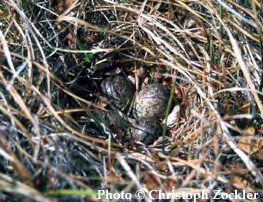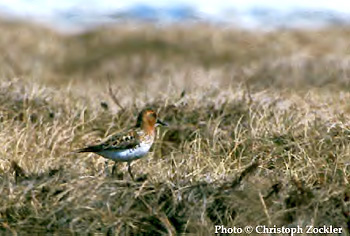Photos by: Christoph Zöckler
Aug 2001
P.S.Tomkovich (1), E.E.Syroechkovski, Jr.(2), C. Zöckler (3), E.G.Lappo (4)
Zool. Museum, Moscow State University, Bol. Nikitskaya Str. 6, Moscow 103009, Russia, e-mail Pavel
Inst. of Ecology and Evolution, Russian Acad. Sci., Leninski Prospect 33, Moscow 117071, Russia, e-mail Evgeny
UNEP- World Conservation Monitoring Centre, 219 Huntingdon Road, Cambridge CB3 0DL, United Kingdom, e-mail Christoph
Dept. of Biogeography, Inst. of Geography, Russian Acad. Sci., Staromonetny Per. 29, Moscow 109017, Russia, e-mail Lena

The Spoon-billed Sandpiper, Eurynorhynchus pygmeus is unique among waders and, with its rare occurrence and localised breeding area in Northeast Russia, is a very charismatic species. It is the only globally threatened sandpiper breeding in the Arctic (BirdLife International 2000). Recent research carried out this summer at selected breeding sites indicates a dramatic decline in the species' fortune. The current global population estimate is between 4,000 and 6,000 birds. There is now evidence that the current population might not exceed 1,000 breeding pairs. Further research and internationally co-ordinated attention and action is required to halt the further decline of the Spoon-billed Sandpiper.
Population size
The Spoon-billed Sandpiper is one of the rarest breeding birds in the Arctic region, breeding exclusively in the Russian Far East and restricted to coastal tundra habitats(Arctic Bird Library).
It is currently listed as vulnerable in the latest IUCN 2000 Red List of Threatened Species (Hilton Taylor 2000, also BirdLife International 2000).

The exact number of Spoon-billed Sandpipers is not known. The most recent estimate of the global population ranges between 4,000 and 6,000 individuals (Rose and Scott 1997). However, there is evidence that the breeding population has declined recently in many breeding sites, such as the Egvekinot area (Dorogoy 1997), and surveys this summer found that it had declined at all of the sites in the surveyed area where previous population estimates were available. Given the high breeding site fidelity (Tomkovich 1994), this suggests that the breeding population of this species has declined sharply in recent decades. The population is now believed to be below 1,000 breeding pairs.
Migration
On migration, the species has been found in Russia along the Pacific coast and islands. It has been regularly recorded in Japan, North and South Korea, China and Hong Kong, Taiwan, India, Bangladesh, possibly in the Maldives, Sri Lanka, Myanmar, Thailand, Vietnam, Philippines, Malaysia (once) and Singapore (Collar et al. 2000).
Throughout its range it appears to be rare on migration and in winter. The largest flock ever recorded was 257 birds in the Ganges delta, Bangladesh (Howes & Parish 1989).
Habitat

The Spoon-billed Sandpiper inhabits a very specific breeding habitat, almost exclusively sea-coasts where there are sandy ridges sparsely vegetated by mosses, dwarf willows and grasses, interspersed with or neighbouring to salt marshes and brackish ponds (Tomkovich 1991). Nests are never further than a distance of 6km from the sea.
Survey in Anadyr region - summer 2000
This summer, an International Arctic Expedition from the Institute of Ecology and Evolution, led by E.E. Syroechkovski at the Russian Academy of Science, surveyed the Anadyr estuary coasts in Chukotka, including lagoons further south, where the southern "core part" of the breeding range of the species has been assumed (Collar et al., 2000).
Several new breeding sites were found. However, numbers were much lower than expected and the species was not recorded in several "promising" areas.
Trend and threats
The results from this year's expedition indicate that the surveyed coasts do not belong, at least currently, to the core part of the species breeding range and the total breeding population may, therefore, be much lower than previously thought.
We checked four sites where Spoon-billed Sandpipers were known to breed previously, but only one displaying male was recorded there. For example, at Gek Cape (64°25' N, 178°15' E) where 8-10 pairs had been breeding in 1933 and at least 5 males displayed in 1991 (Portenko 1939, A.V. Kondratyev, pers. comm.), no Spoon-billed Sandpipers were found in mid July 2000.
The recent results of the 2000 survey in the breeding range indicate a dramatic and continuing decline which may bring the species to the brink of extinction. The reason for the decline is unknown. There are no obvious reasons for the decline within the species' breeding range. We did not observe any major habitat changes while habitat degradation in the breeding area had very local effect. We noticed some disturbance by human activity, but do not think that these are of major concern for the species.

It is postulated that the major reasons for the decline relate to habitat loss at important migration and wintering sites, where many migratory waders are known to face increasing threats from impacts such as wetland reclamation.
The important staging area at Saemangeum, South Korea, including the Mangyung and Tongjin estuaries, has already been partially reclaimed and the remaining wetlands are under serious threat of reclamation in the near future (Collar et al. 2000) (First Draft for the "Asia-Pacific Migratory Waterbird Strategy: 2001 + 2005).
There is, therefore, a significant risk of losing another wader species before we understand the causes. There is little doubt that the current status of the Spoon-billed Sandpiper is critical. The species is no longer simply vulnerable as stated in the recent Red List of globally threatened bird species (BirdLife 2000). The results of the 2000 expedition indicate that the Spoon-billed Sandpiper should be considered as endangered, possibly even critically endangered.
There is an urgent need for further research and monitoring of the Spoon-billed Sandpiper population on the breeding and on the wintering grounds.
In addition immediate conservation action should focus on protecting those sites most threatened by reclamation at their staging and wintering grounds.
"The situation with this species is indeed alarming. We realized two years ago that the situation was not healthy (a paper with those results was published in Bird Conservation International, (2002)12:12-18, a BirdLife International journal) and this summer we undertook another survey to Belyaka Spit, northern Chukotsky Peninsula - the area of my former studies from where good data about numbers of breeding birds are available. The results confirmed our worst expectations: the population has declined about 2.5 times in the 15 years since the previous period of surveys and birds also declined or disappeared from other surveyed sites. Reasons for this situation are not clear: however, a decline all over the breeding range means that any reason is common for the whole population and thus possibly lies outside the breeding range, although low productivity is also possibly a factor. Saemangeum is one of the key sites on the flyway for the species, and its reclamation may become fatal for the remaining population of Spoon-billed Sandpiper."
This feature was originally submitted as a full article to the Oriental Bird Club for publication in their magazine Forktail, and a version also appeared (under the same title) on the Surfbirds web-site.



